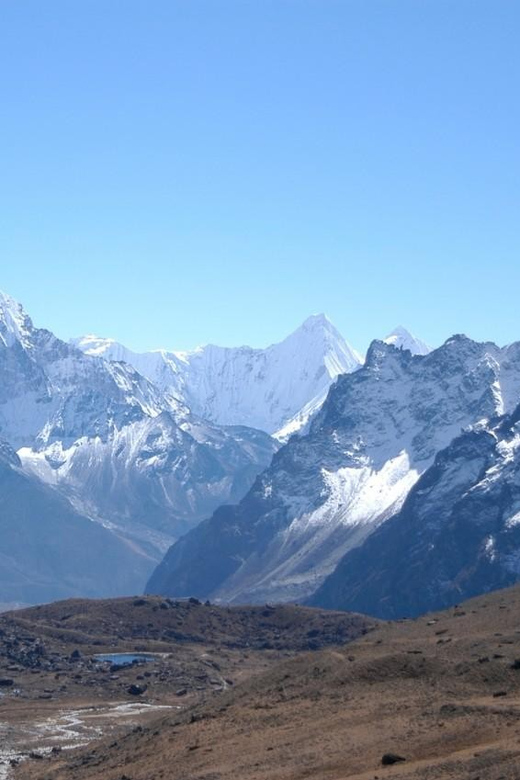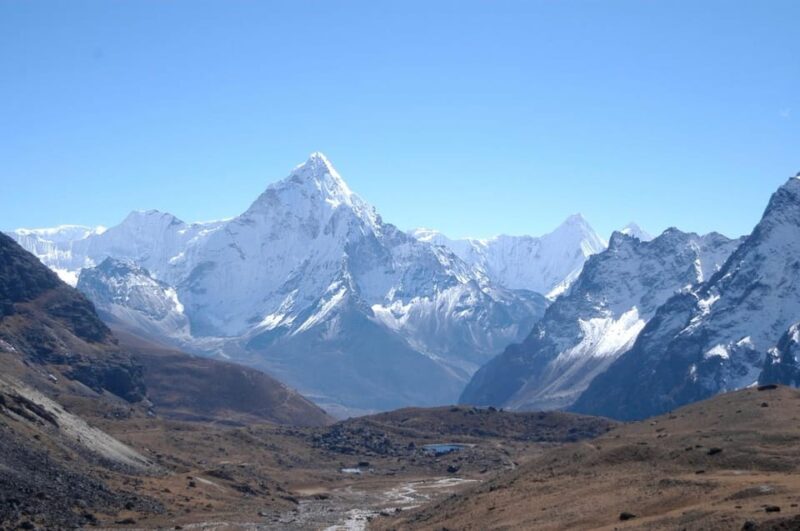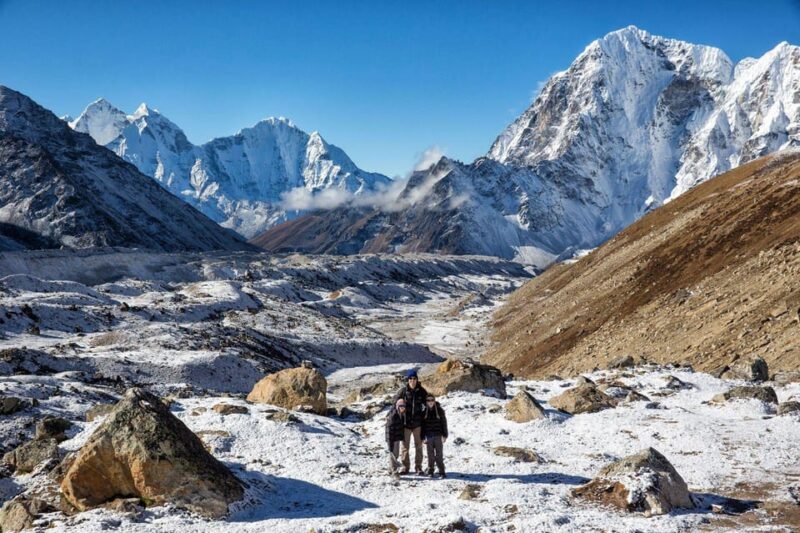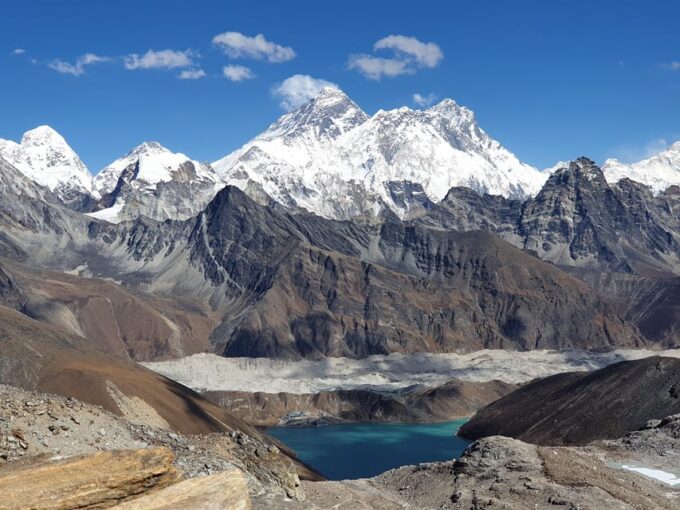The 19-day trek from Kathmandu to Everest Base Camp and Kalapathar offers trekkers a unique blend of adventure and culture in the heart of the Himalayas. As they traverse vibrant Sherpa villages and lush forests, hikers not only witness stunning landscapes but also engage with the local culture. Reaching Everest Base Camp at 5,364 meters and the iconic Kalapathar summit at 5,545 meters unveils breathtaking views that are hard to forget. However, before embarking on this unforgettable journey, there’s much to consider about the planning, preparation, and essential tips that can make a significant difference.
Key Points

- The trek begins with a scenic drive from Kathmandu to Salleri, followed by a series of hikes through picturesque villages.
- Key highlights include acclimatization in Namche Bazaar and spiritual experiences at Tengboche Monastery.
- The journey culminates with a visit to Everest Base Camp and a sunrise ascent to Kalapathar for stunning views.
- Essential inclusions cover permits, experienced guides, comfortable accommodations, and round-trip transfers from Kathmandu.
- Best trekking seasons are spring and autumn, ensuring moderate temperatures and clear skies for an optimal experience.
Overview of the Trek

The Everest Base Camp Trek is a thrilling 19-day adventure that takes trekkers through stunning landscapes, vibrant Sherpa villages, and challenging high-altitude terrain, all culminating at the breathtaking altitude of 5,364 meters.
Starting from Lukla, trekkers embark on a journey that includes iconic locations like Namche Bazaar and the serene Tengboche Monastery.
The trek offers a unique blend of natural beauty and culture, as hikers navigate through dense forests and ascend to spectacular viewpoints.
Notably, reaching Kalapathar, with its summit at 5,545 meters, rewards trekkers with unparalleled vistas of Everest and surrounding peaks.
It’s not just a trek; it’s an unforgettable experience that promises adventure, camaraderie, and awe-inspiring scenery at every turn.
You can also read our reviews of more tours and experiences in Pheriche.
Detailed Itinerary

As trekkers embark on their 19-day journey, the detailed itinerary outlines each day’s adventure, ensuring they experience the best of the Everest region while acclimatizing to the altitude.
The trek begins with a scenic drive from Kathmandu to Salleri, followed by a series of hikes through picturesque villages and lush forests. Key stops include Namche Bazaar, where trekkers rest and acclimatize, and Dingboche, at 4,260 meters.
They’ll trek to Everest Base Camp, seeing the breathtaking landscape, before ascending to Kalapathar for stunning views. Each day balances challenge and beauty, making sure trekkers gain the altitude needed to enjoy this once-in-a-lifetime experience fully.
The journey wraps up with a return drive to Kathmandu, filled with memories of adventure.
Scenic Highlights

Breathtaking vistas unfold at every turn during the Everest Base Camp Trek, captivating trekkers with snow-capped peaks, majestic glaciers, and lush valleys.
As they journey through the Khumbu region, trekkers encounter iconic sights like the towering Ama Dablam and the serene glacial lakes.
The trek also reveals picturesque Sherpa villages, where local culture and traditions come alive.
En route, the stunning Tengboche Monastery provides a spiritual backdrop against the stunning Himalayan landscape.
Reaching Gorak Shep, trekkers stand in awe of the panoramic views, while the ascent to Kalapathar offers an unforgettable sunrise experience over Mount Everest.
Each step taken is filled with natural beauty that leaves trekkers inspired and rejuvenated.
Trekking Inclusions

Trekkers can look forward to a comprehensive range of inclusions that enhance their experience on the Everest Base Camp Trek, ensuring a smooth and enjoyable journey through this stunning landscape.
The trek includes all necessary permits and company paperwork, providing peace of mind from the start. An experienced English-speaking guide will lead the way, with their food, accommodation, and expenses fully covered.
Comfortable accommodations in guesthouses and tea houses during the trek ensure a cozy stay. Round trip transfers by shared bus or jeep make logistics easy.
Plus, trekkers receive a Kathmandu stay with dinner, an emergency first aid kit, and trekking poles available for use, making this adventure not only thrilling but also well-supported.
More Great Tours NearbyEssential Packing List

An essential packing list is crucial for anyone embarking on the Everest Base Camp Trek, ensuring trekkers are well-prepared for the challenges and varying weather conditions they’ll encounter along the journey.
Trekkers should include sturdy trekking boots, warm clothing layers, and a waterproof jacket to handle both cold and wet conditions.
Don’t forget a good-quality sleeping bag, trekking poles, and a daypack for essentials.
A first aid kit, sunscreen, and a reusable water bottle are also vital.
Plus, packing snacks and cash for local purchases can enhance the experience.
Health and Safety Tips

Proper health and safety precautions are essential for anyone planning to trek to Everest Base Camp, as altitude sickness and unpredictable weather can pose significant challenges.
It’s crucial to acclimatize properly by ascending gradually and taking rest days when needed. Staying hydrated helps combat altitude sickness, so trekkers should drink plenty of water daily.
Wearing layered clothing ensures comfort against fluctuating temperatures, and sturdy footwear is vital for navigating rugged trails. Trekkers should also carry a basic first aid kit, including medications for altitude sickness.
Plus, travelers must check weather forecasts regularly and be prepared for sudden changes. Lastly, informing someone about your trekking itinerary can enhance safety and ensure help is available if needed.
Best Trekking Seasons

Choosing the right season for the Everest Base Camp trek significantly enhances the experience, as weather conditions and trail accessibility vary throughout the year. Typically, the best trekking seasons are spring and autumn. During these months, trekkers can expect stable weather, clear skies, and breathtaking views.
Here are the prime trekking seasons:
-
Spring (February to May): Ideal for moderate temperatures and blossoming rhododendrons, this season attracts many trekkers aiming for Base Camp.
-
Autumn (September to November): Offers clear skies after the monsoon, perfect for stunning mountain vistas.
-
Winter (December to January): While quiet, the cold makes trekking challenging, with snow covering the trails.
Selecting the right season ensures memorable adventures and safety on the trails.
Travel Logistics

Traveling to Everest Base Camp involves careful planning and consideration of various logistics to ensure a smooth and enjoyable trek.
First, trekkers should arrange their transportation from Kathmandu to Lukla, typically via a scenic flight or a long drive to Salleri.
Once in Lukla, a well-structured itinerary guides them through key stops like Namche Bazaar and Dingboche.
Accommodation options range from cozy guesthouses to tea houses, providing a warm respite after daily treks.
Obtaining necessary permits is crucial, and experienced guides can facilitate this process.
Lastly, trekkers should pack essential gear, including warm clothing and trekking poles.
With these logistics in place, adventurers can focus on the breathtaking views and the thrill of reaching Everest Base Camp.
Frequently Asked Questions

What Is the Difficulty Level of the Trek?
The trek’s difficulty level is challenging. Adventurers encounter high-altitude terrain, steep ascents, and variable weather. Proper acclimatization and physical fitness are crucial, but with determination, trekkers can conquer the stunning landscapes and breathtaking views.
Are There Age Restrictions for Participants?
There’re age restrictions for participants, as individuals over 95 years won’t be accepted. Generally, younger trekkers find the experience more enjoyable, but participants should ensure they’re fit for the challenging terrain.
Can I Join the Trek Solo?
Yes, you can join the trek solo. However, it’s advisable for solo trekkers to book with a reputable company for safety and support, ensuring they have experienced guides and necessary permits throughout the adventure.
How Do I Acclimatize Properly During the Trek?
To acclimatize properly, trekkers should ascend slowly, stay hydrated, and monitor their body’s responses. They can also take rest days at higher altitudes, allowing their bodies to adjust to the reduced oxygen levels effectively.
What Is the Best Way to Stay Connected While Trekking?
To stay connected while trekking, he suggests using a portable Wi-Fi device or local SIM card. Regular check-ins with loved ones enhance safety, while sharing breathtaking photos keeps everyone engaged in the adventure.
Recap
The 19-day Everest Base Camp and Kalapathar trek from Kathmandu promises an adventure like no other.
With stunning landscapes, rich Sherpa culture, and the thrill of reaching iconic peaks, trekkers will create memories that last a lifetime.
By preparing well and staying mindful of health and safety, anyone can embark on this incredible journey.
So, lace up those boots and get ready to experience the majestic Himalayas—it’s an adventure waiting to unfold!
You can check availability for your dates here:More Hiking & Trekking Tours in Pheriche
More Tour Reviews in Pheriche
Not for you? Here's more nearby things to do in Pheriche we have reviewed
- Everest Base Camp Trek
- Kathmandu: 20 Day Everest Base Camp Trek with Kalapatthar
- Kathmandu : 14 -Day Everest Base Camp with Kala Patthar Trek
- Everest base camp trek 12 days
- Lukla: 11-Day Everest Base Camp Trek from Lukla with Guide
- Nepal: Everest Base Camp with Kalapathar Trek
- From Kathmandu: 12 – Day Everest Base Camp Guided Trek
- Kathmandu: Everest Helicopter Tour with Syangboche Landing
- From Kathmandu: 11- Day Everest Base Camp Trek with Guide
- From Pokhara: 11-Day Budget Everest Base Camp Trek
- Kathmandu : Budget 15-Day Everest Base Camp Trek /2025
- From Lukla: 18-Day Everest Base Camp and Gokyo Lakes Trek
